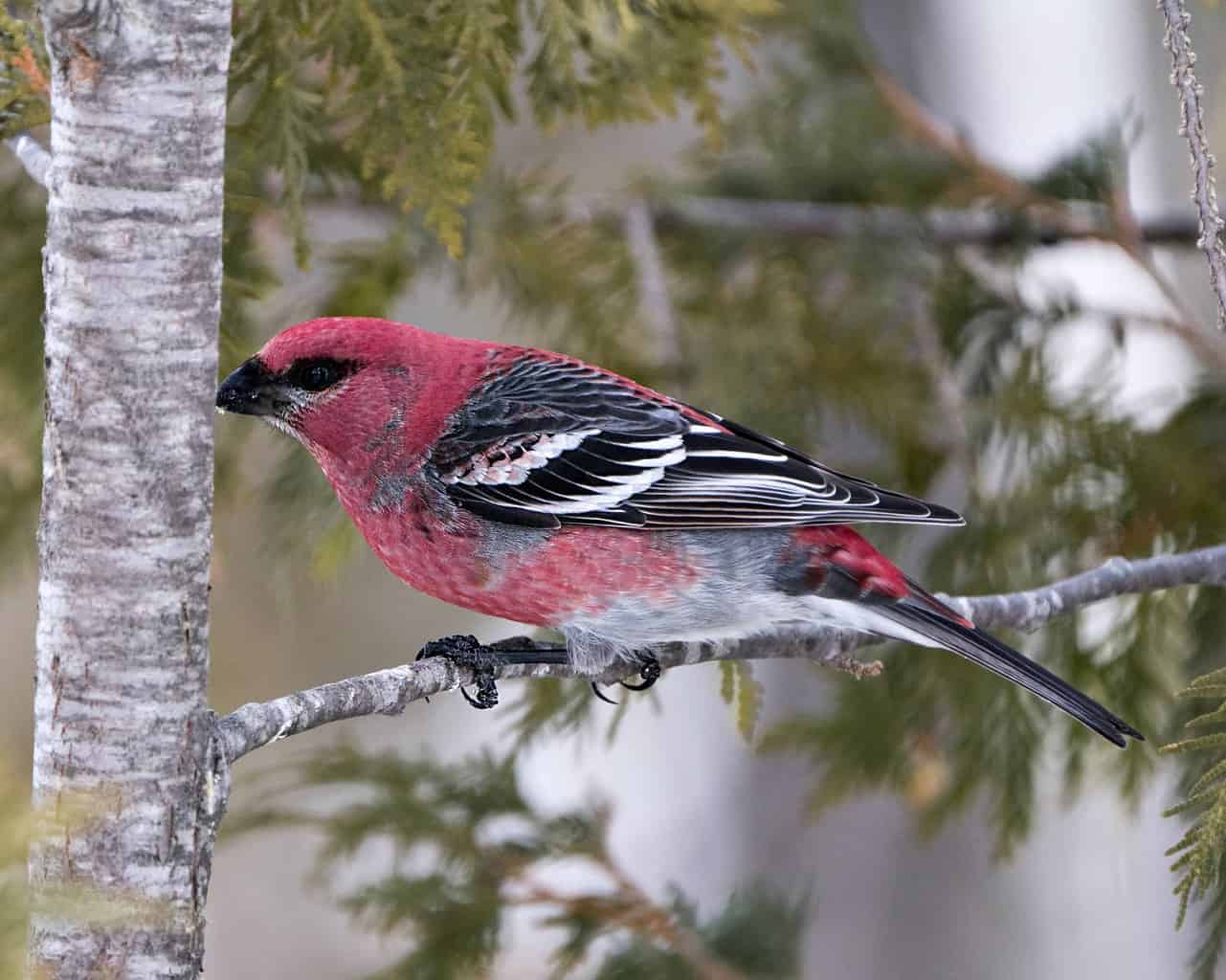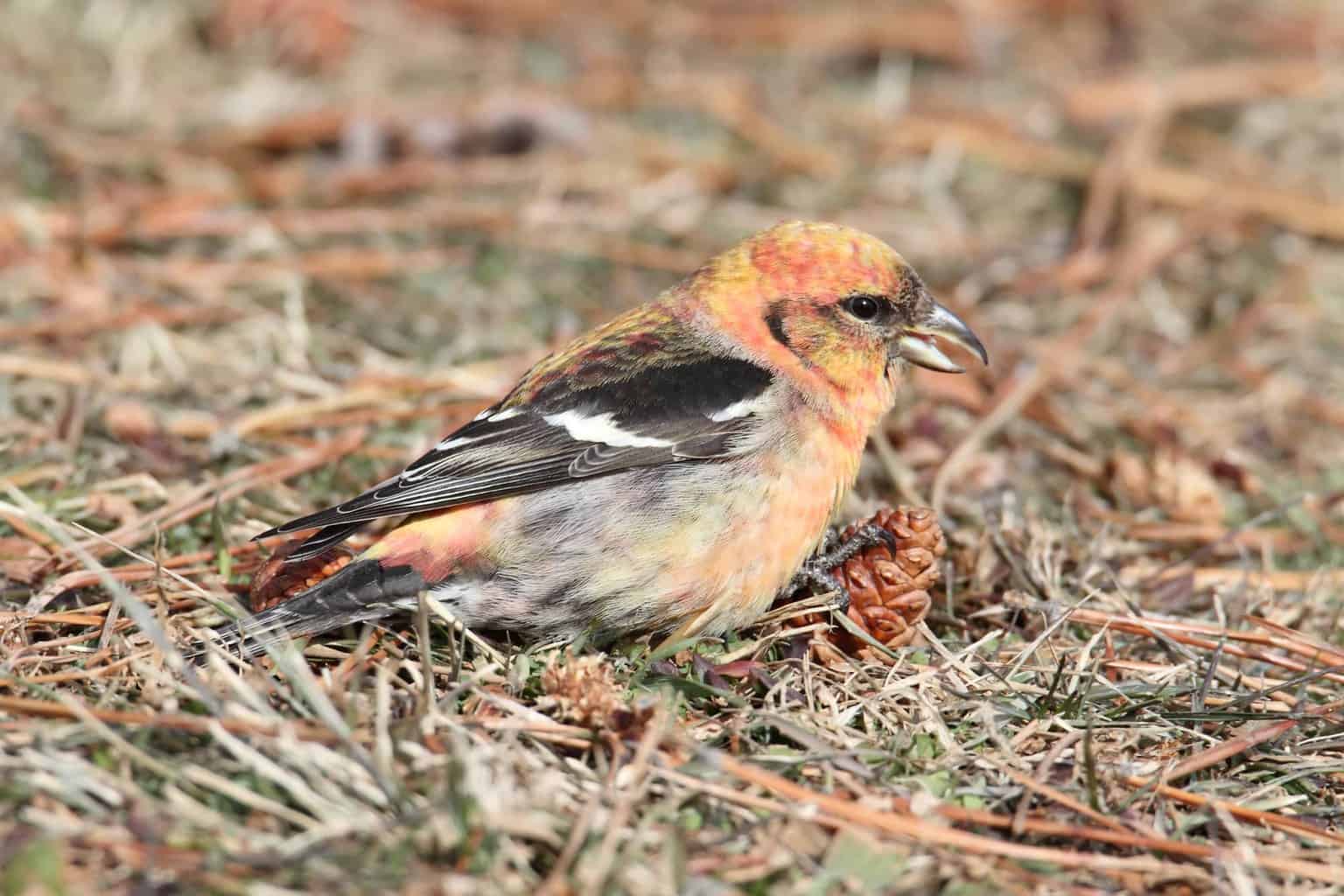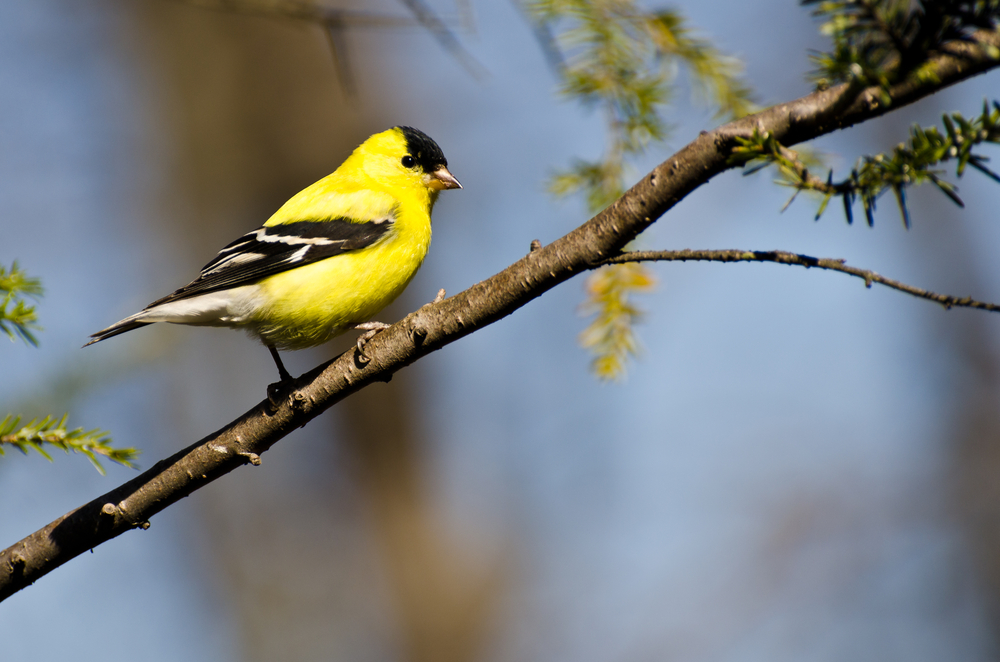Arkansas’ state bird is the Northern mockingbird, a status the clever avian was elevated to almost a century ago, in 1929.
As far as state mascots go, this species seems to be in rather high demand, especially since it is also the state bird of Florida, Mississippi, Tennessee, and Texas.
But perhaps it is no surprise owing to its exceptional ability to imitate the songs of other birds.
Missouri’s southern neighbor is also home to the white-tailed kite known for its penchant for feeding on rodents and for engaging in aerial combat.
There are 424 bird species in Arkansas, 12 of which include finches. Here we’ve provided the most important facts about them in easily digestible, bite-sized nutshells.
Brambling

- Scientific Name: Fringilla montifringilla
- Length: 6 inches
- Weight: 0.8 – 1.02 ounces
- Wingspan: 10 inches
Bramblings are rarely seen in Arkansas. When they make their way to the Americas, they are generally spotted in Alaska. These beautiful finches spend the majority of their time in Eurasia where they live in birch forests.
They can be recognized by plumage which is dark at the head, but which turns orange at the breast, fading to white at the undersurface. Bramblings’ wings are black and orange while their bills are yellow with darkened tips.
Although males and females are similar in color, the plumage of males tends to be more vibrant while the plumage of females tends to be more subdued.
Evening Grosbeak

- Scientific Name: Hesperiphona vespertina
- Length: 6 – 9 inches
- Weight: 1.3 – 3.0 ounces
- Wingspan: 12 – 14 inches
Evening grosbeaks are a large species of finches with powerful beaks. In males, the head feathers are brown interrupted by a thick yellow “eyebrow”, those of the torso and the undertail coverts are a brownish yellow, while those of its wings are black with white centers.
The plumage of females is gray at the head and a milder gray at the torso with a touch of yellow at the throat. Their wings are similar to those of their male counterparts.
Evening grosbeaks are rarely found in Arkansas. However, they may fly that far south during winter in search of food, although such occurrences are uncommon.
Pine Grosbeak

- Scientific Name: Pinicola enucleator
- Length: 8 – 10 inches
- Weight: 2 – 3 ounces
- Wingspan: 13 inches
The plumage of this species is olive at the head and rump in the female and pale gray at the torso. In the male, it is a raspberry red, with touches of gray at the flanks. The wings of the pine grosbeak are black with white wing bars.
Pine grosbeaks can be found in coniferous forests at high elevations. Their favorite foods include berries, buds, and seeds.
The range of this species lies far to the north, in Canada and also in western and southwestern America. The furthest its members generally travel during winter is Lake Erie’s southern shore. As a result, they are rarely found in Arkansas.
Gray-Crowned Rosy-Finch

- Scientific Name: Leucosticte tephrocotis
- Length: 5.5 – 6.3 inches
- Weight: 0.8 – 2 ounces
- Wingspan: 13 inches
These rarely spotted passerines tend to nest in rocky overhangs or rock crevices in tundra or in alpine habitats. They do, however, spend winter at lower elevations.
Gray-crowned rosy-finches have gray heads and black caps. The rest of their plumage is mostly brown although it is flushed through with hints of pink and gray.
These passerines are rarely found in Arkansas. Their range lies to the far west and includes Washington, Idaho, Montana, and California where they can be found all year round. It may also expand during winter as far as western South Dakota and as far south as New Mexico.
House Finch

- Scientific Name: Haemorhous mexicanus
- Length: 5 – 6 inches
- Weight: 0.6 – 0.9 ounces
- Wingspan: 8 – 10 inches
These rosefinches are generally covered in plumage which is a mild brown. Their undersurfaces are pale and covered in brown streaks. Males are covered in an additional flush of vivid red at their heads, throats, and chests. Occasionally this coloring may also extend to their upper surfaces. Females, on the other hand, lack the red coloring present in males.
House finches are found throughout Arkansas all year long. They are also found in the same capacity in the states which lie to its north, including Missouri, Tennessee, Kansas, etc.
Purple Finch

- Scientific Name: Haemorhous purpureus
- Length: 4.7 – 6.3 inches
- Weight: 0.63 – 1.10 ounces
- Wingspan: 10 inches
Purple finches are stocky passerines with large heads. Male members of this species are covered in a cool pinkish red at the head, chest, and back surfaces. Females on the other hand are somewhat darker compared to house finches and exhibit streaking which is more detailed in comparison.
Purple finches visit Arkansas in winter where they can be spotted throughout the state. They can however be found throughout the year along the Pacific Coast and in the northeastern United States.
Common Redpoll

- Scientific Name: Acanthis flammea
- Length: 4.5 – 5.5 inches
- Weight: 1.12 ounces
- Wingspan: 8 – 9 inches
Common redpolls are tubby little finches heavily covered in dark brown streaks. They are generally darker compared to hoary redpolls. Like their hoary redpoll relatives, they sport a dark red patch on the forehead. Male common redpolls’ chests may also be colored in a pink flush.
This active little finch is rarely seen in Arkansas. It breeds and winters in Canada, only occasionally moving further south to the northern United States in search of food.
Red Crossbill

- Scientific Name: Loxia curvirostra
- Length: 7.9 inches
- Weight: 2 ounces
- Wingspan: 12 inches
Male red crossbills are covered in strawberry red plumage which may also have hints of brownish grey. Their wings are dark in comparison, as are their crossed beaks.
Female red crossbills, on the other hand, are by no means as colorful and are covered in olive plumage with hints of gray. They also have dark wings similar to their male counterparts.
The beaks of red crossbills are specially adapted for prising conifer seeds open: all they have to do is bite between the scales and lift out the nutritious seed concealed inside the cone.
Red crossbills are not commonly found in Arkansas. Their range lies to the north in central and southern Canada, and the western and southwestern United States.
However, they have been known to travel as far south as Louisiana and Mississippi during winter and may be seen in Arkansas, as a result.
White-Winged Crossbill

- Scientific Name: Loxia leucoptera
- Length: 5.7 – 6.7 inches
- Weight: 0.9 – 1.40 ounces
- Wingspan: 11 inches
A rather energetic species, its male members are colored in a bold raspberry red with a dark patch at the cheek. Females have brownish-green heads while their undersurfaces are gray.
Their black wings display prominent white wing bars while their mandibles are crossed over each other. This species is nomadic and can be found in coniferous forests particularly those in which spruce and tamarack can be found.
White-winged crossbills prefer to feed on conifer seeds, especially those with small cones. They are partial to firs, larches, and spruces. They will also feed on insects when available.
White-winged crossbills are not commonly seen in Arkansas since the state lies south of the furthest point of their winter range.
The species generally spends all its time in Canada and Alaska although the northernmost parts of Washington, Montana, and Michigan are also included in its vast range.
Pine Siskin

- Scientific Name: Spinus pinus
- Length: 4 – 5.5 inches
- Weight: 0.40 – 0.60 ounces
- Wingspan: 7 – 9 inches
A heavily streaked plumage is the main feature of this talkative, social species, in addition to prominent yellow wing bars which can be seen when its wings are spread in flight.
Pine siskins also have brown cheeks, pale eyebrows, and hints of yellow at their forked tails as well.
Their bills are also slender and tapered.
This species prefers to feed on conifer seeds, insects, and spiders. They can be found in coniferous and mixed coniferous forests as well as parklands and suburbs.
Pine siskins may visit Arkansas in winter owing to food shortages during an irruption year. However, they mainly spend the warmer months in Canada, the northern United States, and the western United States.
Lesser Goldfinch

- Scientific Name: Spinus psaltria
- Length: 3.5 – 5 inches
- Weight: 0.3 – 0.4 ounces
- Wingspan: 6 – 8 inches
Female members of this species are a drab olive at their upper surfaces and a dull yellow at their under surfaces. They also have black winged feathers edged with white which create a noticeable contrast.
Males also have the same coloring on the upper surface. Their wings are also the same color and pattern as females’. However, they sport a black cap and lemon-yellow undersurfaces.
Lesser goldfinches are rarely spotted in Arkansas. Their range lies to the west starting from western Texas. However, a few vagrants may be spotted in Oklahoma’s eastern neighbor.
American Goldfinch

- Scientific Name: Spinus tristis
- Length: 5.5 inches
- Weight: 0.4 – 0.7 ounces
- Wingspan: 8 – 9 inches
The summer plumage of American goldfinches is an even yellowish tan for females and golden citrus for males.
Male members of the species also sport a black cap as well as white barring on dark wing feathers.
With the arrival of winter, both males and females look rather similar in terms of plumage with their heads being a darker gray and their bodies being a rather more subdued shade of the same color.
American goldfinches can be found throughout Arkansas all year round with the exception of its southern part where they spend the winter.
Conclusion
If you happen to live in Arkansas, you would be treated to sightings of house finches and American goldfinches, on a regular basis. You would however have to wait until winter to admire raspberry-hued purple finches or even red crossbills, or pine siskins.
Others, yet still might prove more elusive. Included in that list are bramblings, evening and pine grosbeaks, gray-crowned rosy-finches, lesser goldfinches, and common redpolls.
And yet the fact they rarely visit that far south certainly makes a glimpse of them extra special and a cause for celebration for bird watchers everywhere.

